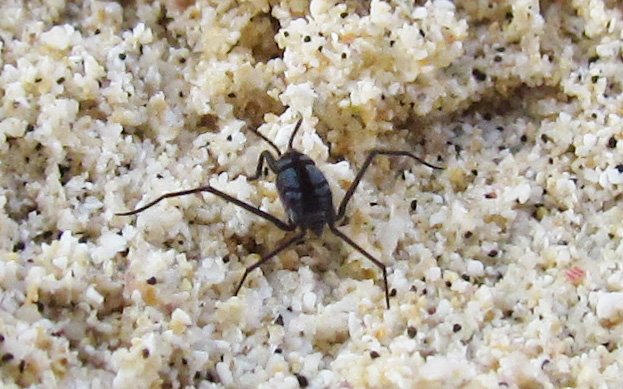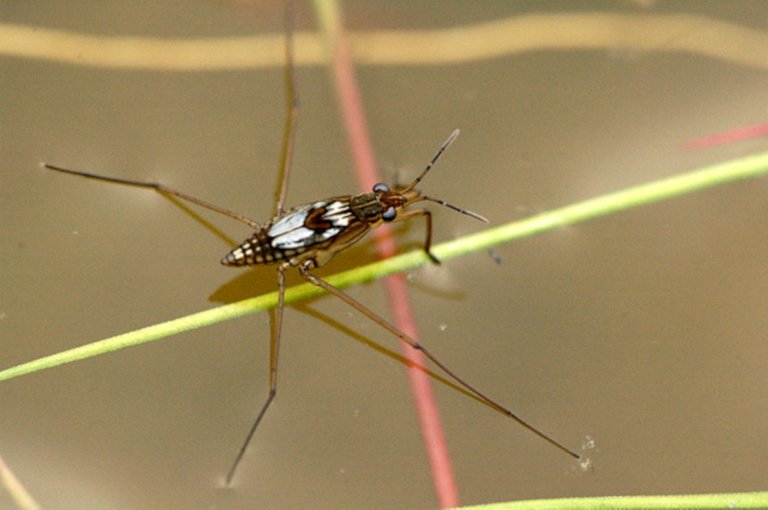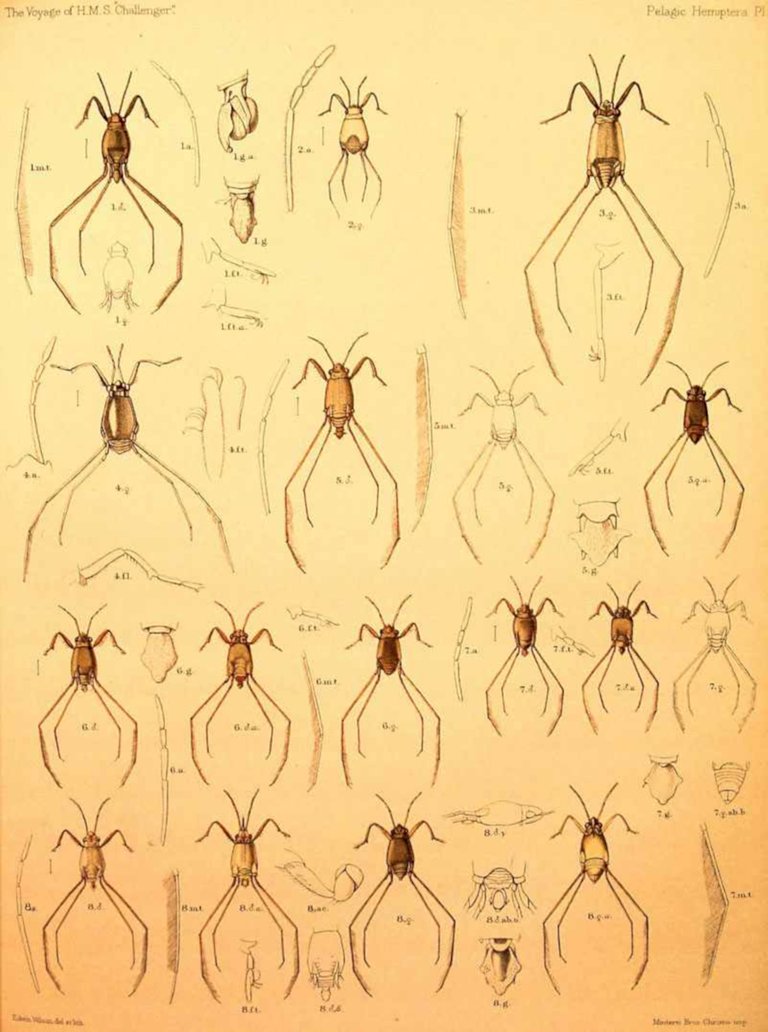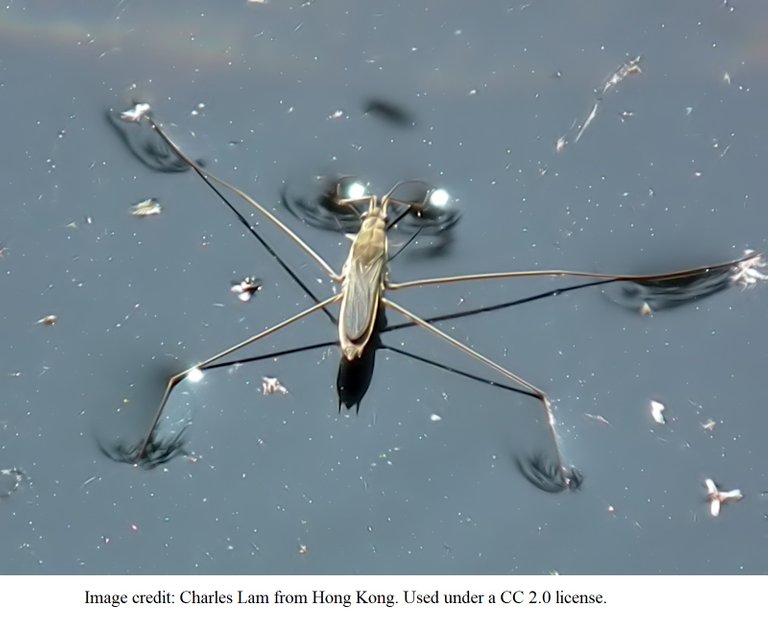They Walk on Water: Gerridae
There are between 2 and 30 million (identified and unidentified) insect species in the world. Of these, it is estimated that only 750 to 1,400 are water walkers. An even smaller number of species, five, live their lives on the open seas. But even these ocean-dwelling insects do not live their entire life cycle underwater.
Here is a YouTube video, that shows the magic of water walkers:
All species of water walkers are in the Gerridae family. Those that live at sea and in coastal areas are a branch of Gerridae, called Halobates.
Coastal Halobate, Castle Beach, Kailua (Oahu), Hawaii

Image credit: Cory Campora. Used under a CC 2.0 license

Lanna Cheng, of the Scripps Institute of Oceanography, explains how insect species became aquatic:
Some 300 million years ago, insects left swampy environments and evolved physiologically so they could become terrestrial, ..."independent of water or damp places..." Their adaptations included the development of wings and tracheal breathing systems. In order to make the transition to existence on water, the insects had to once again adapt physiologically.
Common Gerridae, Tegeler Fleiss, Germany

Image credit: JoyofNature. CC 4.0 license.
The adaptations included legs that enable the insects to remain buoyant. The legs of Gerridae are covered with thousands of microscopic hairs. These hairs are "scored with tiny groves in which air is trapped. The trapped air helps to keep the insect afloat. Microscopic hairs on the insect's body also prevent water from flooding the tracheal system. This protects the strider from drowning.
According to Mathew Miller, writing in Cool Green Science, the arrangement and specialized function of the strider's six legs are part of its success as a water walker.
The two middle legs are used as paddles. In this YouTube video you can see the strider paddling with its middle legs.
The front legs are used for seizing prey and for mating. Below are pictures that show 1) a water strider feeding on a fly, and 2) striders mating:
Water Strider Feeding on a Fly

Image creditIldar Sagdejev (Specious). Used under a Creative Commons Attribution-Share Alike 3.0 Unported license.
Mating Gerridae

Image credit: KKPCW. Used under a CC 4.0 license.
The two long back legs of the strider help to propel the animal forward and are also used to brake and steer. Watch the back legs in this Youtube video.
The Mechanics of Walking on Water
Gerridae are able to move across water because of surface tension. According to the National Wildlife Federation, surface water molecules are attracted to each other and through this attraction form a kind of thin membrane. Gerridae navigate on top of this membrane. If a water strider's legs break the surface tension, it is very difficult for the insect to recover its stride, and it may actually drown.

A True Bug
Sometimes, when we use the term 'bug', we may feel we are being inaccurate or overly casual. However, in the case of Gerridae, we are being accurate when we call these insects 'bugs'. They are 'true bugs'. They actually belong to a bug order called Hemiptera.
Here's a YouTube video that explains characteristics of true bugs:
One distinguishing trait of true bugs is their manner of eating. They all have mouth parts that are shaped like beaks and have a long straw-like extension through which they suck up nutrients. The saliva of the Gerridae contains a paralyzing enzyme. Here's a Youtube video (not pleasant to watch) of a water strider feeding on a fly while a fish tries to steal dinner.
Gerridae are predators that will eat live animals and carcasses. They will eat their young, even their own progeny. However, at least one study demonstrated that there seems to be some kin recognition--that is, Gerridae may be less likely to eat their own progeny.
Gerridae Nymph (Gerris gibbifer)

Image credit: James Lindsey's Ecology of Commanster Site CC 2.5 license

Conclusion
I began reading about Gerridae when I learned that, except for five species, there are no known insects that live entirely out on the ocean. The ocean dwellers, Halobates, were first discovered in 1822 by an Estonian naturalist, Johann Friedrich Eschscholtz.
In 1883, in a landmark voyage on the Challenger, F. Buchanan-White issued a report on Halobates, which reflected further research and understanding.(Information derived from a paper written by Jon L. Herring for the Bishop Museum.) The diagram below came from the Challenger report.

Image credit: F. Buchanan White, Plate from the Challenger Report on the Pelagic Hemiptera. 1883. Public domain
The key to this diagram:
- Halobates micans (as Halobates wullerstorffi) 2.Halobates micans 3.Halobates princeps 4.Halobates micans (as Halobates streatfieldanus) 5.Halobates sobrinus 6.Halobates germanus 7.Halobates sericeus 8.Halobates hayanus
The five pelagic Halobates that have been identified so far as living entirely at sea are micans, sericeus, sobrinus,germanus, and splendins. The last is not shown on the diagram. It is believed that there are more species that have not yet been discovered.
My interest in halobates, and Gerridae in general, has only increased with the writing of this blog. I hope to learn more and may share what I learn in future blogs.
Note
***The accent Gif used in the blog was made from a Pixabay photo by Analogicus.

***The license link for the picture at the top of the blog by Charles Lam: Wikimedia Commons



!discovery 35
Thank you @phage93, for your notice and support :)
This post was shared and voted inside the discord by the curators team of discovery-it
Join our community! hive-193212
Discovery-it is also a Witness, vote for us here
Delegate to us for passive income. Check our 80% fee-back Program
I very much appreciate being 'discovered'. Thank you @discovery-it. An honor to be noticed by you :)
https://twitter.com/A_G_Moore/status/1337167065787092997
A great blog about a small number of insects that inhabit the earth and are a mystery to the general population. The pictures and videos are fascinating. Kudos to you for your interest in this topic.
Thank you @pokerm! I'm very glad you found my blog interesting. I think these are fascinating creatures, also :)
Fascinating blog! Next time I get a mosquito bite at the beach I won't just look to the sky, I'll check the surface of the water too..
😄
Thank you very much for those kind words. I appreciate your support and interest.
You always have interesting info on nature. These water walkers are amazing.
Tip
Thank you my friend, for your kind words and your generous tip :)
I love nature, as I know you do. These blogs are an adventure and a pleasure to write.